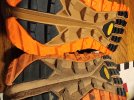kensteve51
New Member
- Time of past OR future Camino
- September 2023
I had read on the forum about life of shoes. Never in the world would I have thought about mileage on shoes.
If you look closely at the photo you will see what 8 months and about 850 miles did to my wonderful Altra Olympia 5 trail runners.
Look closely at the center of my new shoe on the left and the old shoe on the right.
Following others advice here on the forum, wearing Fox River sock liners, Darn Tough moreno wool socks, and the wide toe box of the Altras, no blisters during my eight months of training! Hope my luck holds on the Camio. Also on advice from the forum, started wearing my new shoes today to break then in before my pilgrimage in a few weeks.
Only 32 more days until I start my journey to St.Jean PP. Hope to take my first step on September 20th. My goal is to make my way from St.Jean to Fenstera, enjoying the walk, in 48 days...never getting in a hurry.
I hope to meet some of you along the way
If you look closely at the photo you will see what 8 months and about 850 miles did to my wonderful Altra Olympia 5 trail runners.
Look closely at the center of my new shoe on the left and the old shoe on the right.
Following others advice here on the forum, wearing Fox River sock liners, Darn Tough moreno wool socks, and the wide toe box of the Altras, no blisters during my eight months of training! Hope my luck holds on the Camio. Also on advice from the forum, started wearing my new shoes today to break then in before my pilgrimage in a few weeks.
Only 32 more days until I start my journey to St.Jean PP. Hope to take my first step on September 20th. My goal is to make my way from St.Jean to Fenstera, enjoying the walk, in 48 days...never getting in a hurry.
I hope to meet some of you along the way
















